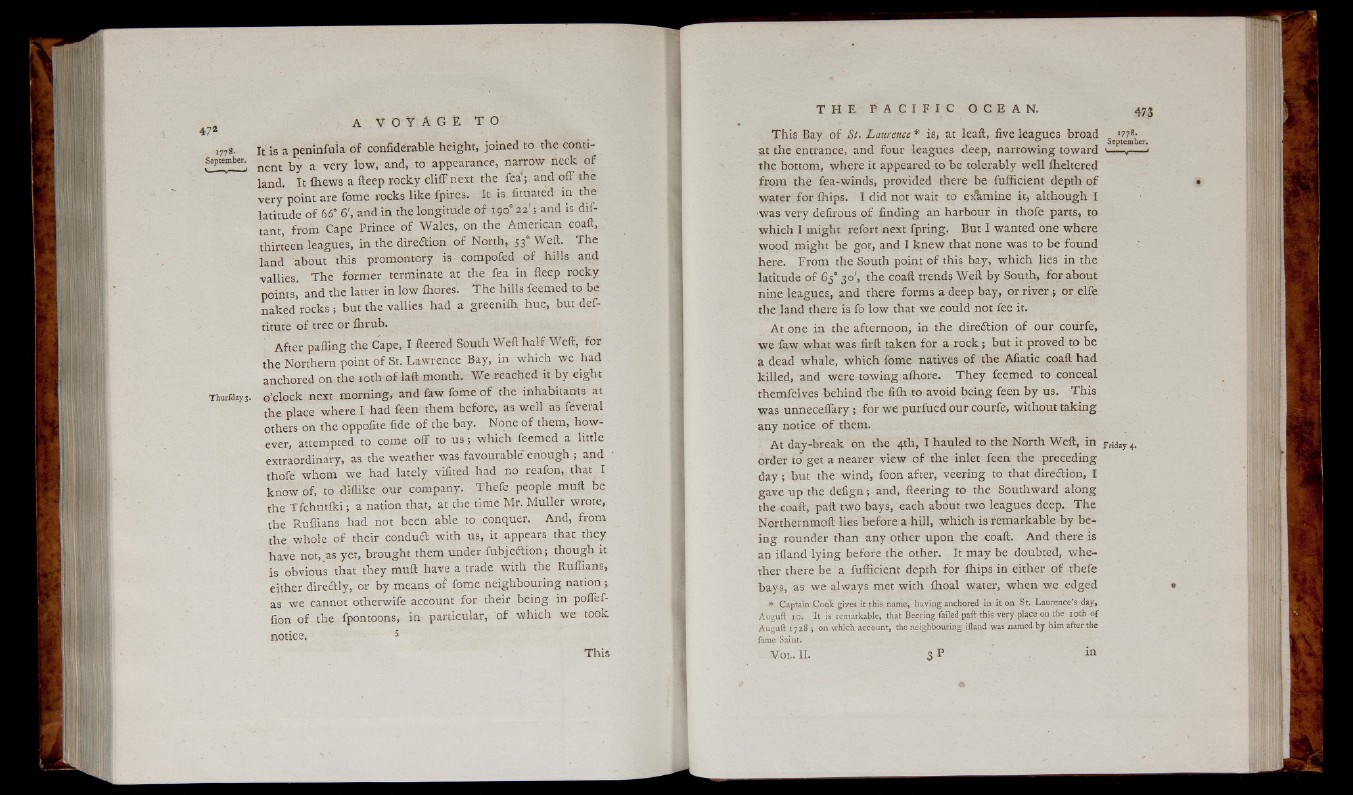
1778- It. is a peninfuia o f confiderable he ight, joined to the conti-
September-. nent b y a ve ry low, and, to appearance, narrow neck o f
land, i t ihews a fteep rocky c liff next the feaV and o ff the
ve ry point are fome rocks lik e fpires. It is fituated in the
latitude o f 66° 6', and in the longitude o f 190° 22'; and is dif-
tant, from Cape Prince o f Wales,- on the American coaft,
thirteen leagues, in the direction o f North, 53° Weft. The
land about this promontory is compofed o f hills and
vallies. T he former terminate at the fea in fteep rocky
points," and the latter in low ihores. T h e hills feemed to be
naked rocks j but the vallies had a greeniih hue, but def-
titute o f tree or flirub.
After palling the Cape, I fleered South Weft h a lf Weft, for
the Northern point o f St. Lawrence Bay, in w hich we had
anchored on the 10th o f laft month. We reached it by eight
Thuifday3. o’c lo ck next morning, and faw fome o f the inhabitants at
the place where I had feen them before, as w e ll as feveral
others on the oppofite fide o f the bay. None o f them, how ever,
attempted to come o ff to u s ; w hich feemed a little
extraordinary, as the weather was favourable' enough ; and
thofe whom w e had la te ly vifited had no reafon, that I
kn ow of, to diflike our company. Thefe people muft be
the T fch u tfk i; a nation that, at the time Mr. Muller wrote,
the Ruffians had not been able to conquer. And, from
the whole o f their conduit with us, it appears that they
have not, as yet, brought them under fubj e ftio n ; though it
is obvious that they muft have a trade with the Ruffians,
either dire&ly, or by means o f fome neighbouring nation ;
as w e cannot otherwife account for their being in pollef-
fion o f the fpontoons, in particular, o f w hich we took
notice. 5
T h is Bay o f St. Laurence * is, at leaft, five leagues broad „ ' 77*; J September.
a t the entrance, and four leagues deep, narrowing toward v *
the bottom, where it appeared to be tolerably well flickered
from the fea-winds, provided there be fufficient depth o f •
water fo r fliips. I did not wait to examine it, although I
w a s very defirous o f finding an harbour in thofe parts, to
w hich I migh t refort next fpring. But I wanted one where
wood might be got, and I kn ew that none was to be found
here. From the South point o f this bay, w hich lies in the
latitude o f 65" 30', the coaft trends Weft by South, fo r about
nine leagues, and there forms a deep bay, or river ; or elfe
the land there is fo low that we could not fee it.
At one in the afternoon, in the direition o f our cotirfe,
w e faw what was firft taken for a r o c k ; but it proved to be
a dead whale, w h ich fome natives o f the Afiatic coaft had
killed, and were towing alhore. T h e y feemed to conceal
themfelves behind the fifli to avoid being feen by us. This
was un n ece ffa ry; for we purfued our courfe, without tak ing
any notice o f them.
A t day-break on the 4th, I hauled to the North Weft, in Friday ^
order to get a nearer view o f the inlet feen the preceding
d a y ; but the wind, foon after, veering to that direction, I
gave up the d e fign ; and, fleering to the Southward along
the coaft, paft two bays, each about two leagues deep. The
Northernmoft lies before a hill, w h ich is remarkable by bein
g rounder than any other upon the coaft. And there is
an ifland ly in g before the other. It may be doubted, whe ther
there be a fufficient depth for fliips in either o f thefe
bays, as we always met with flioal water, when we edged *
* Captain Coqfe gives it this name, having anchored in it on St. Laurence’s day,
Auguft 10. It is remarkable, that Beering failed paft this very place on the io th o f
Auguft 1728 ; on which account, the neighbouring ifland was named by him after the
fame Saint.